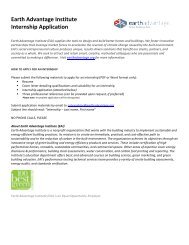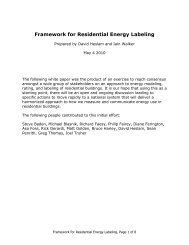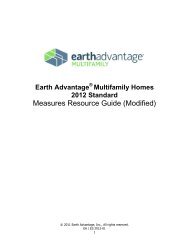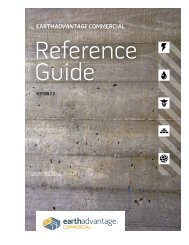EA New Homes Measures Guide - Earth Advantage
EA New Homes Measures Guide - Earth Advantage
EA New Homes Measures Guide - Earth Advantage
You also want an ePaper? Increase the reach of your titles
YUMPU automatically turns print PDFs into web optimized ePapers that Google loves.
2012 <strong>Earth</strong> <strong>Advantage</strong> Residential<br />
<strong>Measures</strong> Resource <strong>Guide</strong><br />
1.3.1<br />
Energy Modeling: Use EPS energy scoring system<br />
Energy<br />
Land Materials<br />
Calculated<br />
Description: Energy efficiency is fundamental to green building. <strong>Earth</strong> <strong>Advantage</strong> requires a minimum level of energy efficiency that is 10<br />
percent better than building code. The Energy Performance Score (EPS) score is used to calculate EPS points for all energy-related<br />
measures in this Points Worksheet. When the EPS value is reduced beyond the 10 percent minimum performance requirement, additional<br />
<strong>Earth</strong> <strong>Advantage</strong> points are granted. Once the EPS reaches the 10 percent improvement threshold, two <strong>Earth</strong> <strong>Advantage</strong> points are granted<br />
for every one EPS point reduction. <br />
<br />
A Home Energy Rating (HERS) can be provided upon request for an additional fee.<br />
Health<br />
Water<br />
Benefit: The Energy Performance Score assigned to this house allows you to compare energy use with other houses. This is especially<br />
useful when the time comes to sell the home. In Energy Trust of Oregon territory, prospective buyers can use EPS to shop for a home that<br />
meets their energy performance expectations.<br />
Verification: <strong>EA</strong> Rater enters the EPS value in this measure to calculate corresponding.<br />
1.3.2<br />
House Size<br />
Energy<br />
Land Materials<br />
Calculated<br />
Description: Houses less than 2200 sq. ft. receive 1 energy point for every 50 sq. ft reduction. For example, a home that is 1800 sq. ft<br />
would receive 8 energy points, while a 1500 sq. ft. home would receive 14 energy points. These points are granted in addition to points<br />
calculated by the Energy Performance Score (Measure 1.3.1). The reason for this two-pronged points allocation is to compensate for the<br />
disadvantage that smaller homes have in gaining points through the other method. In addition, one materials point is given for each 200<br />
sq. ft. reduction in size below 2000 sq. ft.<br />
Health<br />
Water<br />
Benefit: This measure encourages smaller, space-efficient designs. The size of the average house in the United States has grown to almost<br />
2,400 sq. ft. At the same time, households have fewer people. House size affects every aspect of energy and resource efficiency, including<br />
energy use, material use, furnishings, and even the quantity of cleaning chemicals. Smaller houses allow greater development density,<br />
which reduces infrastructure costs and supports mass transit systems. House size is the most significant environmental issue, so smaller<br />
houses are rewarded with significant points in Land and Materials.<br />
Verification: <strong>EA</strong> Rater will determine conditioned floor area from house plans and measurements made at the site.<br />
1.3.3<br />
Accessory Dwelling Unit (attached or detached)<br />
Energy<br />
Health<br />
Materials<br />
Water<br />
0 0 3 2 0<br />
Description: Build an accessory dwelling unit (ADU) on the same lot as the primary residence. The ADU can be attached or detached. The<br />
ADU must be built to the same specifications and best practices as the primary residence.<br />
Land<br />
Benefit: Providing flexibility and adaptability for different family configurations over time can provide more<br />
density of people within the home. This reduces the overall impacts of the home on a per person basis. ADU spaces can also act as office<br />
spaces to allow telecommuting and potentially reduce transportation impacts of work commuting.<br />
Verification: <strong>EA</strong> Rater will verify that the ADU is built to the same energy specifications as the primary residence.<br />
Page 7 of 70








